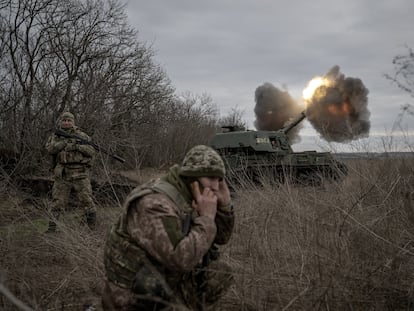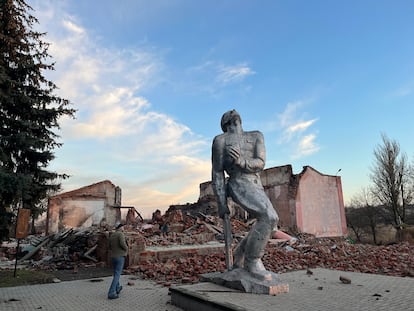Night mission with a Ukrainian brigade operating bomb-carrying drones on the Bakhmut front
As Ukraine repels Russia’s invasion, drones have become essential due to their speed, price and manageability. Kyiv wants to manufacture a million of these devices in 2024
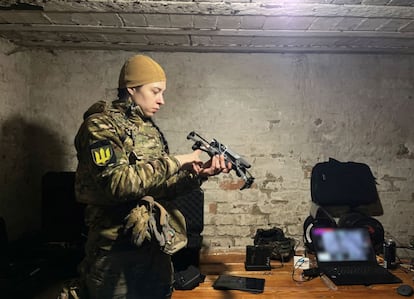

The sun fades into the hills of Donbas region. The driver turns off the lights, accelerates and travels — almost by memory — down the potholed road to the position from which the team will launch its drones against the Russian troops.
They work at night. The full moon illuminates the road, but also the vehicle. Little balls of fire stitch the sky. The Bakhmut front in eastern Ukraine is where artillery thunders and bombs hum. “If they hit us, we won’t see it — we’ll feel it,” Annya muses, adjusting her helmet. The soldier and her companion, Yaroslav, get out of the car when it’s still moving. They cross the frozen mud, enter a basement and unpack their materials. They’re at ground zero, where the fighting is grinded out foot by foot. Yaroslav takes out one of the drones and hooks a projectile to it. With one of these, you could blow up a tank. “The Russians seek to hunt us, but we see them. And we can reach them,” he says.
Russian soldiers are less than a mile from the position from which the Ochi (“Eyes”) Brigade operates its drones. The area is extremely dangerous and the car cannot be left unattended. Yuri — the group’s driver, a burly military veteran of the Donbas War — will pick up his companions when the first light of day breaks. Yaroslav strokes his sharp, straw-colored beard and lifts his head out of the cellar, clutching one of the devices. Annya sips an energy drink and checks the coordinates on a laptop screen, where the Russian positions are revealed. The night is long.
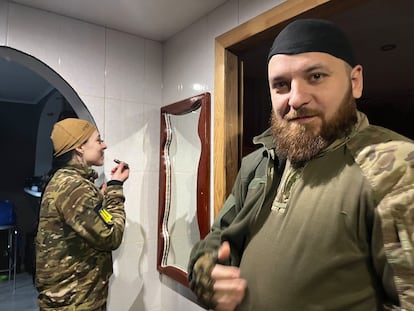
The battle is intense. With a lack of ammunition — and with the Ukrainian army’s dependence on Western aid — combat drones have become crucial. The fierce fight put up by Soviet-made tanks and artillery, along with sharp defenses and quagmires developed with techniques more typical of 20th century warfare, is increasingly becoming a battle of drones. Above all, Russia and Ukraine use light and affordable unmanned aerial vehicles and “adapt them to their military needs,” explains Marina Miron, a researcher in the Department of War Studies at King’s College London. “The reality on the battlefield has created a need that cannot be met quickly enough by the military industry,” the expert adds. This is why drones and electronic warfare have proliferated.
Previously, the Ochi Brigade operated during the day and mainly utilized civilian reconnaissance drones, such as the Chinese-made DJI Mavic quadcopters. These are equipped with good cameras, which can detect Russian positions that will subsequently be targeted by artillery brigades. However, few drone operators want to work at night, explains Yaroslav (following the rules of the Ukrainian military, soldiers don’t reveal their surnames). And even less so in the villages surrounding Bakhmut, the fortress city that ended up falling into Russian hands last summer, after the bloodiest urban battle of the war. Still, the brigade reformed and began to work in the dark. And, little by little, they also introduced drones adapted to attack: quadcopter aircraft were renovated to launch projectiles and grenades or to hit targets, like kamikazes. “It’s them or us,” Annya shrugs.

The team now also manages the first-person view (FPV) drones, which are very manageable, fast and relatively cheap. Projectiles are attached to them with harnesses and zip ties that the soldiers manufacture with a 3D printer. Most of the time, the Ochi Drone Brigade and similar units finance spare parts and materials out of their own pockets, or by raising donations. In the damp basement, illuminated by a light bulb, Yaroslav puts on his goggles, which he wears when he operates the FPV drone. It’s not a video game. The war launched by Russia, which is heading into its third year, has claimed tens of thousands of lives, destroyed thousands of homes, created millions of refugees and blown up the global security framework.
Military drones have been key in wars for years. Ukraine has Leleka-100 drones and has also used the Turkish-made Bayraktar, which also provided an ocean advantage for Azerbaijan in the war against Armenia in Nagorno-Karabakh, in 2020. Between April and May of 2022, Marina Miron explains, the Ukrainians began using smaller commercial drones for surveillance and reconnaissance. They later adapted them to attack Russian equipment and personnel. The Kremlin caught up “very quickly” and introduced Iranian-made Shaheds. Now, both armies employ drones to solve battlefield tasks, correct artillery fire and overwhelm air defense systems. Russia also uses them in swarm attacks, combined with missiles.
There are drones that can be adapted for reconnaissance or attacks for between $400 and $2,000, depending on how tactical they’re expected to be. The cost also varies greatly for the Russians. “An Iranian Shahed 136 drone costs about $20,000, while a Kalibr missile [Russian-made] costs $950,000. Of course, [a Shahed] doesn’t cause the same level of damage,” Miron clarifies.
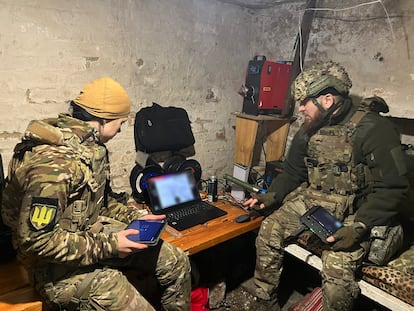
Electromagnetic warfare
For military analyst Mijailo Samus, this will “definitely” be the year of combat drones. The Ukrainian army now has an attack company that deploys these aircraft in almost every brigade. Those who operate this technology will eventually end up becoming a specific branch, like the Ukrainian Marine Corps or Air Forces, Samus notes. But while Ukraine has shown itself to be superior in the handling of naval drones — such as those it has used to attack the Black Sea Fleet or the Kerch bridge in Crimea — Miron warns that Russia has developed a series of “countermeasures” to protect its equipment and has deployed several electromagnetic warfare systems (known as EW), such as the Shipovnik Aero, which it also uses to shoot down Ukrainian drones. These systems can also impact a drone’s navigation or communication with the pilot. And here is where the Kremlin has an advantage.
Kyiv is now working on a new project to train 2,600 FPV drone pilots. Samus notes that the next step will be to integrate artificial intelligence, to make it easier to find the tanks and armored vehicles belonging to enemy troops on the battlefield. “With this, an operator could use several drones at the same time,” the expert points out.
The Ochi Brigade, meanwhile, is looking for a third operator. At the moment, their schedule is always the same: they sleep during the day, they manufacture more material for the aircraft, they go to the position at full speed under the rain of artillery that illuminates the sunset and they operate their drones from the basement. It’s the same thing, night after night.
Two years ago, Annya had another life. The soldier, a 34-year-old physiotherapist, lived in Kyiv with her boyfriend. They had plans and dreams. She was born and raised in the Donetsk region and lived through the Donbas war. When Russia accumulated troops along the Ukrainian borders, she joined the Territorial Defense Forces and began receiving training.
On February 24, 2022, when Russian President Vladimir Putin launched his attacks against Ukraine by land, sea and air, Annya and her boyfriend enlisted. The Russians killed him last winter. She changed brigades in the spring. She now operates bomb-carrying drones in one of the toughest enclaves of the battle, while rockets and mortars resound. “I think that here, for now, I can contribute, make a difference,” she says. Next to her, between cables, is Yaroslav, a 35-year-old father of three children. Before the full-scale invasion, he ran a company in Kyiv. He’s now been in the quagmire of Donbas for almost two years. Both are finding it increasingly difficult to remain engaged in civilian life.
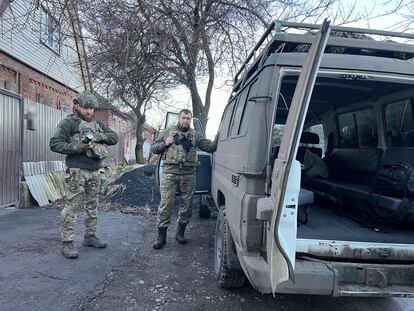
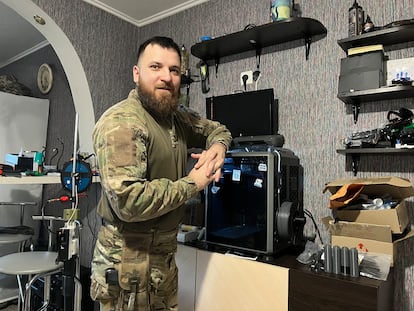
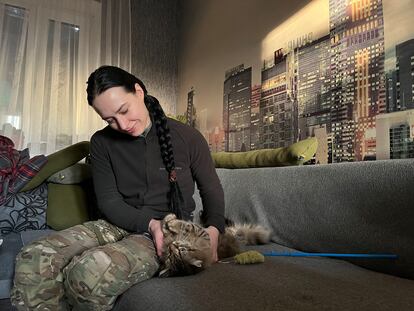
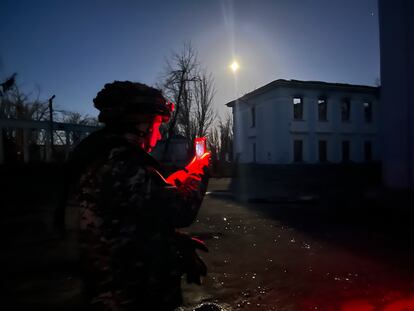
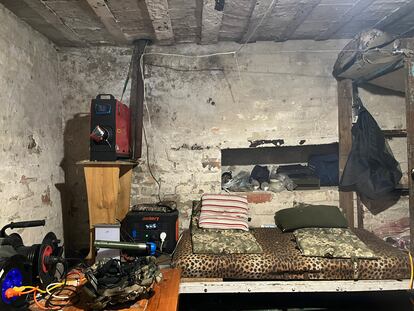

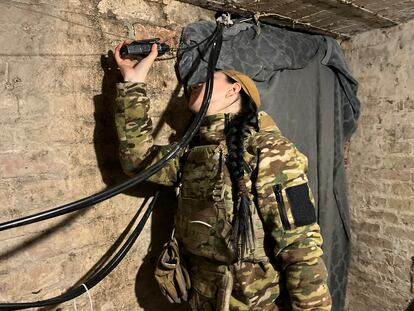
Outside the basement, in the gray villages along the Bakhmut front, there’s almost no one left. In Chasiv Yar — a town where some 12,500 souls lived before the invasion — only the bombs can be heard. In July, a Kremlin attack destroyed the Palace of Culture, which served as a delivery point for humanitarian aid. The building is now a mass of rubble. On one of the facades, graffiti shows Valerii Zaluzhnyi, the commander-in-chief of the Armed Forces, making the “V” for victory sign. Russia’s war against Ukraine has become entrenched in the area. Moscow’s soldiers have taken over some of the positions that Ukrainian troops had recaptured in the spring.
The invaded country is preparing for a long war, while fearing that Western support will falter and the funds that keep the country afloat — and pay for the weapons that allow it to resist — will stop arriving. Kyiv is trying to increase the domestic manufacturing of weapons and drones. This is according to what Alexander Kamyshin has told EL PAÍS. He’s Ukraine’s minister of strategic industries. According to his calculations, in 2024, his country will be able to produce one million FPV drones, more than 10,000 medium-range bomb-carrying drones — which can travel between 350 and 500 miles — and 1,000 long-range kamikaze drones, which can reach 620 miles.
“Ground robotic systems are also vital,” the minister adds. “They can save lives by replacing soldiers on the battlefield. Functions such as demining, medical evacuation and logistics — which are very dangerous — can and should also be carried out by robots.” Kamyshin also assures this newspaper that, after the war, Ukraine will become a key global player in this type of technology. “Drones are changing the rules of the game in this war,” he affirms.
For the Ochi Brigade, everything has already changed. From the basement where a small generator hums, they recount better times when they couldn’t imagine themselves in a dark quagmire, or in the middle of the snow launching drone strikes at the Kremlin’s forces. “Russia wants to erase our nation, end our democracy. This is a war and each of us are doing what we can,” Annya says. “I don’t know if Europe is ready,” Yaroslav sighs, “but if Putin advances, he won’t stay in Ukraine. And there will be many people like us, many basements like this.”
Sign up for our weekly newsletter to get more English-language news coverage from EL PAÍS USA Edition
Tu suscripción se está usando en otro dispositivo
¿Quieres añadir otro usuario a tu suscripción?
Si continúas leyendo en este dispositivo, no se podrá leer en el otro.
FlechaTu suscripción se está usando en otro dispositivo y solo puedes acceder a EL PAÍS desde un dispositivo a la vez.
Si quieres compartir tu cuenta, cambia tu suscripción a la modalidad Premium, así podrás añadir otro usuario. Cada uno accederá con su propia cuenta de email, lo que os permitirá personalizar vuestra experiencia en EL PAÍS.
¿Tienes una suscripción de empresa? Accede aquí para contratar más cuentas.
En el caso de no saber quién está usando tu cuenta, te recomendamos cambiar tu contraseña aquí.
Si decides continuar compartiendo tu cuenta, este mensaje se mostrará en tu dispositivo y en el de la otra persona que está usando tu cuenta de forma indefinida, afectando a tu experiencia de lectura. Puedes consultar aquí los términos y condiciones de la suscripción digital.
More information
Archived In
Últimas noticias
Most viewed
- David King, chemist: ‘There are scientists studying how to cool the planet; nobody should stop these experiments from happening’
- Reinhard Genzel, Nobel laureate in physics: ‘One-minute videos will never give you the truth’
- Mexico completes its trade shift with the entry into force of tariffs on China and countries without trade agreements
- Oona Chaplin: ‘I told James Cameron that I was living in a treehouse and starting a permaculture project with a friend’
- Sinaloa Cartel war is taking its toll on Los Chapitos
